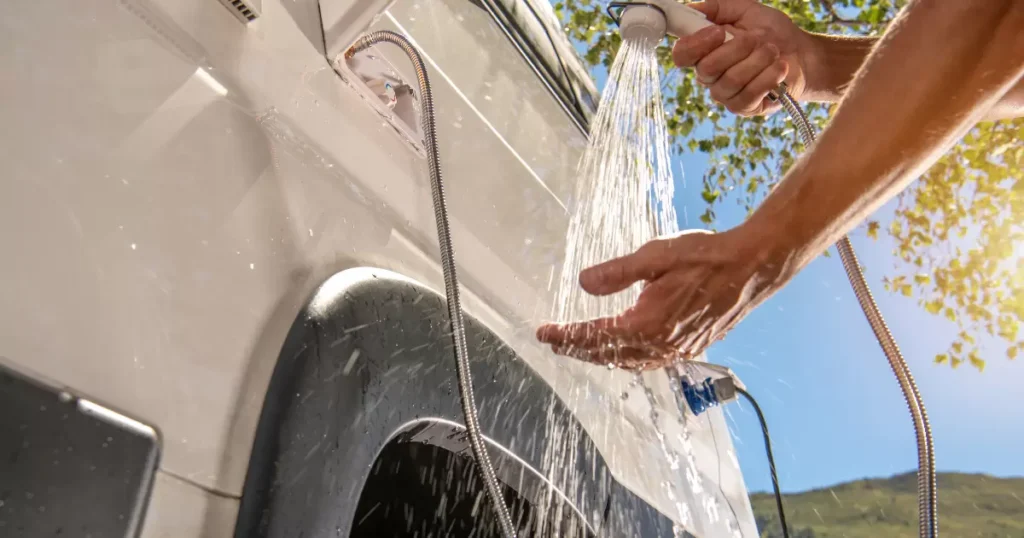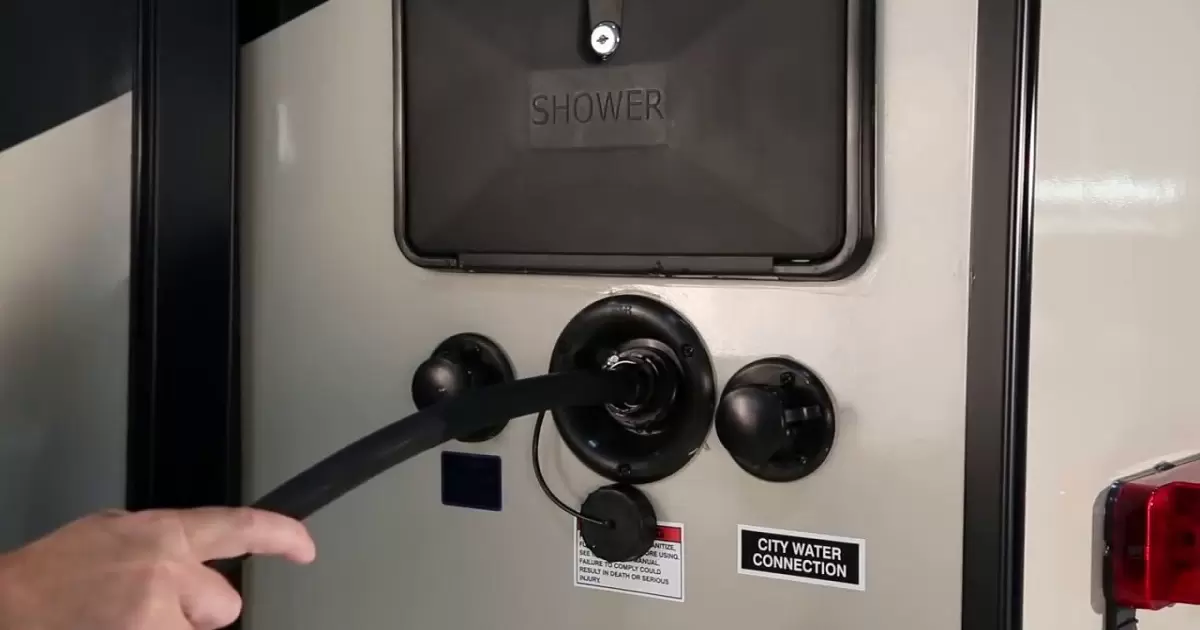Filling an RV fresh water tank is a straightforward but essential task for any RV owner or enthusiast. Essentially, it involves adding clean water to the RV’s onboard storage tank, which then supplies water for various uses inside the RV, such as in the kitchen, bathroom, and for any washing needs.
Have you ever wondered, How To Fill an RV’s Fresh Water Tank? It’s a question that might seem simple, but the answer is crucial for anyone planning a trip in an RV. Ensuring you have a sufficient water supply is not just a matter of convenience; it’s a vital aspect of your journey. adventure.
The process of filling an RV freshwater tank involves several steps to ensure both safety and efficiency. First, you need to locate the water fill port on your RV, which is typically clearly marked. Then, using a clean, safe hose designated for drinking water, you connect the hose to a potable water source and fill the tank.
A Journey into the Essentials of RV Living: Ensuring a Fresh Water Supply
Embarking on an RV adventure promises freedom, flexibility, and the joy of the open road. However, to fully embrace this nomadic lifestyle, one must understand the critical aspects of RV maintenance, with a primary focus on managing your fresh water supply.
This introductory guide on How To Fill RV Fresh Water Tank is tailored for both seasoned RV enthusiasts and novices alike, providing essential insights into a task that is vital yet often overlooked.
The importance of a reliable fresh water supply while on the road cannot be overstated. Whether you’re parked in a remote, tranquil forest, or stationed at a bustling RV park, the ability to access fresh water is crucial for everyday activities such as cooking, cleaning, and personal hygiene. T
The process of filling your RV’s fresh water tank might seem mundane, but it is the backbone of a comfortable and enjoyable RV experience.
Demystifying the Basics: What Does Filling Your RV’s Fresh Water Tank Involve?

The phrase How To Fill RV Fresh Water Tank might initially appear straightforward, yet it encompasses a range of practices, techniques, and considerations that are crucial for maintaining a safe and enjoyable RV experience. This session aims to break down the concept, helping RV owners understand not just the ‘how,’ but also the ‘why’ behind this essential task.
Fundamentals of the Fresh Water Tank in an RV
The freshwater tank in an RV is a dedicated storage unit designed to hold a supply of potable water. This tank is integral to the RV’s plumbing system, providing water for drinking, cooking, showering, and other daily needs.
The capacity of these tanks varies depending on the RV’s size and design, ranging from small tanks in compact campers to large ones in luxurious motorhomes.
Filling the Tank: More Than Just Adding Water
Filling the RV fresh water tank involves more than just pouring water into a container. It’s a process that ensures the availability of clean, safe water throughout your journey. This task includes:
- Identifying the Right Water Source: Using potable water, which is safe for consumption, is paramount.
- Using the Proper Equipment: Employing hoses and attachments specifically designed for potable water to prevent contamination.
- Monitoring the Filling Process: Keeping an eye on the water level to avoid overfilling, which can lead to damage or leaks.
Why is it Important?
Understanding the significance of a properly filled freshwater tank extends beyond mere convenience. It’s about safety, health, and the sustainability of your RV lifestyle. Ensuring you have a sufficient and safe water supply is critical, especially when traveling to remote areas where access to water might be limited.
| Aspect | Reason for Importance |
| Health and Safety | Ensures access to clean, safe drinking water, crucial for good health. |
| Convenience | Provides water for all needs, from cooking to hygiene, while on the go. |
| Self-Sufficiency | Enables travel to remote areas without worrying about water access. |
| RV Maintenance | Prevents damage to the RV’s plumbing system from running dry. |
| Emergency Preparedness | Keeps a vital resource at hand in case of unforeseen circumstances. |
Properly filling your RV’s fresh water tank goes beyond mere routine; it is a fundamental aspect of ensuring a comfortable and safe journey. Whether you’re in a remote location or a fully-equipped campground, a reliable water supply is key to a successful RV experience.
Step-by-Step Process for Ensuring a Safe and Adequate Water Supply
In this session, we dive into the practical aspects of filling your RV’s fresh water tank. This comprehensive guide aims to equip you with the knowledge and tips necessary to perform this task efficiently, ensuring a safe and reliable water supply throughout your travels.
Step 1: Preparing for the Task
- Identify the Fresh Water Fill Port: This is your starting point. Locate the fill port on your RV, usually marked and often located on the vehicle’s exterior side.
- Ensure You Have the Right Equipment: Use a hose that is safe for drinking water, often designated as an RV or marine-grade hose. This helps avoid any harmful contaminants leaching into your water supply.
Step 2: Connecting to a Water Source
- Find a Potable Water Source: Ensure the water source is safe for consumption. Many campgrounds and RV parks provide designated potable water spigots.
- Connect the Hose: Attach one end of your hose to the spigot and the other to your RV’s fill port. Ensure the connection is secure to avoid leaks.
Step 3: Filling the Tank
- Begin Filling the Tank: Turn on the water supply. Keep the flow moderate to prevent pressure buildup in the tank and plumbing system.
- Monitor the Water Level: Most RVs have a gauge to monitor the water level. Avoid overfilling as it can damage the tank and system.
Step 4: Completing the Task
- Shut Off the Water Supply: Once the tank is filled to the desired level, turn off the water supply.
- Disconnect the Hose: Carefully disconnect the hose and allow any remaining water to drain out.
- Store the Hose Properly: To prevent contamination, store your hose in a clean, dry place designated for drinking water equipment.
Step 5: Post-Filling Checks
- Check for Leaks: Once the tank is filled, inspect the system for any leaks or issues.
- Sanitize the Tank Regularly: Regularly cleaning and sanitizing your tank is crucial for maintaining a safe water supply.
Addressing Common Challenges
- Dealing with Limited Water Sources: In remote areas, plan your water usage wisely and know the locations of reliable water sources along your route.
- Maintaining Water Quality: Regularly sanitize your tank and use a water filter to ensure water quality.
Encapsulating the Essentials: A Recap of RV Water Management
As we conclude our comprehensive guide on how to fill an RV freshwater tank, let’s summarize the key points:
- Preparation is Key: Locate the fill port and use the correct hose.
- Source Potable Water: Always fill your tank with safe, drinkable water.
- Careful Filling: Monitor the filling process to prevent overfilling.
- Post-Filling Checks: Perform leak checks and regular maintenance.
Filling your RV’s fresh water tank is more than a routine task; it’s a critical step in ensuring a safe, enjoyable, and worry-free RV journey. By understanding and following these steps, RV enthusiasts can ensure they have a reliable water supply wherever their travels take them.
Emphasizing Water’s Role in RV Travel
Maintaining a fresh water supply is essential for a comfortable RV experience. Regularly filling, monitoring, and maintaining the tank ensures not only the availability of water but also its safety and quality. Remember, the journey in an RV is not just about the destinations but also about how comfortably and safely you can travel to them.
Frequently Asked Questions (FAQs)
How often should I fill my RV’s fresh water tank?
This depends on your water usage and the tank’s capacity. Monitor your levels regularly and refill as needed.
Is it necessary to use a special hose?
Yes, it’s important to use a hose designated for drinking water to prevent contamination.
How do I know when the tank is full?
Most RVs have a gauge. Also, an overflow valve or a change in sound can indicate fullness.
Can I fill my tank with water from any source?
It’s crucial to use potable water only, to ensure safety and avoid health risks.
How do I maintain the cleanliness of the water tank?
Regular sanitization and cleaning of the tank are essential. Use appropriate cleaning agents and flush the system periodically.
By adhering to these guidelines and answers, RV owners can ensure a continual supply of fresh water, essential for a successful and enjoyable RV adventure. Remember, every aspect of RV maintenance, including water management, plays a vital role in crafting memorable and comfortable journeys on the road.
Conclusion
Filling your RV’s fresh water tank is a crucial step in preparing for any road adventure. It ensures that you have access to clean, safe water for all your needs, from cooking to cleaning. By following a simple process of using the right equipment and sourcing potable water, you can maintain a reliable water supply in your RV. Regular checks for leaks and routine tank maintenance are essential to keep your water system in top condition. With these practices, you can enjoy uninterrupted comfort and convenience on your travels.
Understanding the importance of this task and executing it properly enhances the overall RV experience. Whether you’re a seasoned traveler or new to the RV lifestyle, managing your water supply effectively is key to a successful journey. So, the next time you set out on the road, remember that a well-filled fresh water tank is not just a requirement, but a step towards a smooth and enjoyable adventure.









